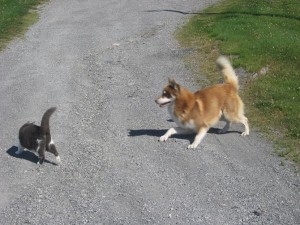Can old pets be spayed or neutered safely?
Yes, they can! And in most cases, it is even good for their health and in some cases spaying or neutering can prevent an early death,
Here is what Dr. Ian Crane, a veterinarian at the Animal Surgery and Wellness Centre in Pasadena, has to say about it:
Question: Dr. Crane, is it dangerous for an old cat or dog to have it spayed or neutered?
- Personally (and certainly most veterinarians would agree) I believe that the risk of anesthetic has to do with health and not age. As dogs get older, they can get unhealthier as the organs age, etc., but they can also remain healthy until very old. And the opposite. Some younger animals may have severe health issues.
Question: Do you consider a seven-year-old cat or dog as old?
– 7 years is still considered middle age (at the most).
Question: Some people say that they don`t want an older cat or dog to be fixed – and then the animal has litter after litter.
– I believe giving birth is far riskier that getting spayed.
Question: What can be done to keep the risk for older pets as low as possible?
– Bloodwork can help to eliminate most concerns about underlying problems.
Question: We have read that having the pets fixed can even prevent some lethal illnesses. Is this correct?
Older intact male dogs are far, far, far more likely to have prostatitis, tumors of the prostate, testicular tumors and peri-anal tumors (all of the tumors may be malignant).
And many older intact female dogs will get Pyometra which will require surgery (when debilitated at that stage) or they will die without surgery.
Question: What about unfixed cats?
Older mature male cats are more likely to stink-out your house and fight. These cats tend not to live very long unless neutered.
Intact females are significantly more likely to get mammary tumors each time they go through heat. In fact it is additive/accumulative. Older intact females of both dogs and cats are extremely likely to have mammary tumors.
Question: Some animals gain weight after being fixed. Maybe they need less food and more exercise?
- It is correct that neutered/spayed animals can gain more weight. But owners can control this. (Its a small price to pay).
Here is the interview with Dr. John Earle, a veterinarian in Zurich, Ontario.
Question: Dr. Earle, some people worry about the risks involved with spaying and neutering an old pet. What would you tell them?
Dr. Earle: I understand their concern but I do feel that spaying and neutering even a mature animal is less risky and more responsible than not having it done.
Question: What are the risks for an old animal if it is not fixed?
Everytime a bitch or a queen goes through a heat there is a higher risk of the female developing an infected uterus. The hormones of the heat allow the uterus to accept an impending pregnancy and therefore also relax the immune system`s surveillance of the environment. If they don’t get pregnant a bacteria can get inside and cause a pyometra or pus in the uterine lumen. These animals get very sick and only survive if they have the uterus removed and go on antibiotics.
If a female is spayed the ovaries are removed and there is no chance of the pet getting cancer of the uterus or ovaries and less chances of mammary tumours.
Unneutered male dogs can develop a testosterone driven tumor around the anus. It is not present in neutered pets. Of course neutering males also removes all of the unwanted offspring that he can sire.
Also in cats, intact adults have a much greater chance of contracting feline AIDS and leukemia.
Question: How can the risks during surgery for spaying or neutering be kept as low as possible for old pets?
The risk of surgery in an older animal is a little higher – just as it is in humans – but the anaesthetics we use are very safe, and if an owner is very concerned, blood tests can be done to make sure the internal organs are healthy.
Do you know the law? The Highlights of the new Animal Protection Act. Click here.
Read this article about Solving the Stray and Unwanted Dog Problem. Click here.
Cats: Do The Math!
An unspayed female cat, her mate and all of their offspring, producing 2 litters per year, with 2.8 surviving kittens per litter, can total:
1 year: 12
2 years: 67
3 years: 367
4 years: 2,107
5 years: 11,801
6 years: 66,088
7 years: 370,092
8 years: 2,072,514
9 years: 11,606,077
(Source: Pick of the Litter Society)

“Willow” from Noddy Bay
Could Pets Keep Kids Healthy?
Babies who live with dogs and cats during their first year of life are healthier, say researchers in Finland.
Specifically infants living in a house-hold with a dog developed 31 per cent fewer respiratory infections, 44 per cent fewer ear infections, and received 29 per cent fewer prescriptions for antibiotics than those without a dog.
And infants in households with pets that regularly spent time outdoors were found to reap even more health benefits.”

Cat Muffy and dog Storm from Noddy Bay

